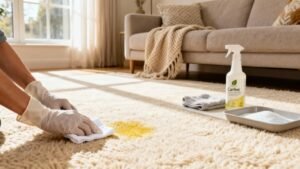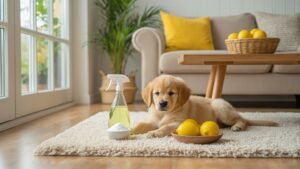When I’m choosing pet-safe carpet cleaners, I always look for enzymatic formulas with plant-based ingredients like sodium percarbonate—they break down organic stains without harsh chemicals that could harm my furry friends. I’ve found that products like Kids N Pets and OxiClean work great, or you can make your own using white vinegar and baking soda. The key is avoiding toxic additives while ensuring the cleaner actually eliminates odors at the protein level. There’s actually much more to creating a truly pet-safe cleaning routine.
Table of Contents
ToggleUnderstanding Pet-Safe Carpet Cleaning Products and Ingredients
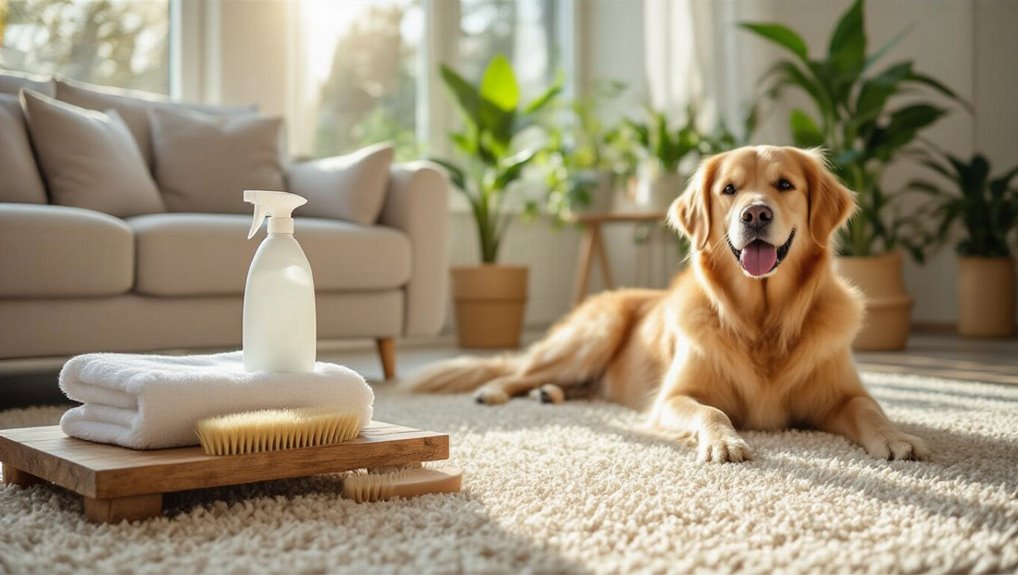
When you’re trying to keep your carpets clean while protecting your furry family members, understanding what goes into pet-safe cleaning products becomes, well, pretty essential.
I’ve learned that the best cleaners safe for pets rely on natural ingredients rather than harsh chemicals that could harm your dog or cat.
Plant-based enzymes are actually game-changers for pet urine and stain and odor removal.
They break down organic matter naturally without creating toxic fumes.
I’m particularly drawn to products containing sodium percarbonate and baking soda – these ingredients neutralize odors effectively while remaining free from harmful additives.
Simple solutions like vinegar and baking soda work surprisingly well too.
These natural alternatives tackle tough stains without harsh chemicals, making them perfect for households with pets who spend time on carpeted areas.
Effective Non-Toxic Methods for Pet Stain and Odor Removal
Now that you know which ingredients to look for, let’s talk about putting them to work on those inevitable pet accidents.
I’ve found these methods consistently tackle stubborn pet stains without harsh chemicals:
- Enzymatic cleaners – Products like Kids N Pets break down stains at the protein level, eliminating urine odors completely when you keep the area moist for proper enzyme action.
- Vinegar and baking soda combo – This environmentally friendly duo creates a fizzing reaction that lifts pet odor from carpet fibers, though use sparingly.
- Professional hot water extraction – High-temperature cleaning with biodegradable detergents provides thorough, safe for use treatment.
- Oxygen-based spot treatments – OxiClean’s sodium percarbonate formula eliminates stains and odors in ten minutes, free from harsh dyes for effective cleaning.
Top Animal-Safe Carpet Cleaning Solutions for Pet Owners
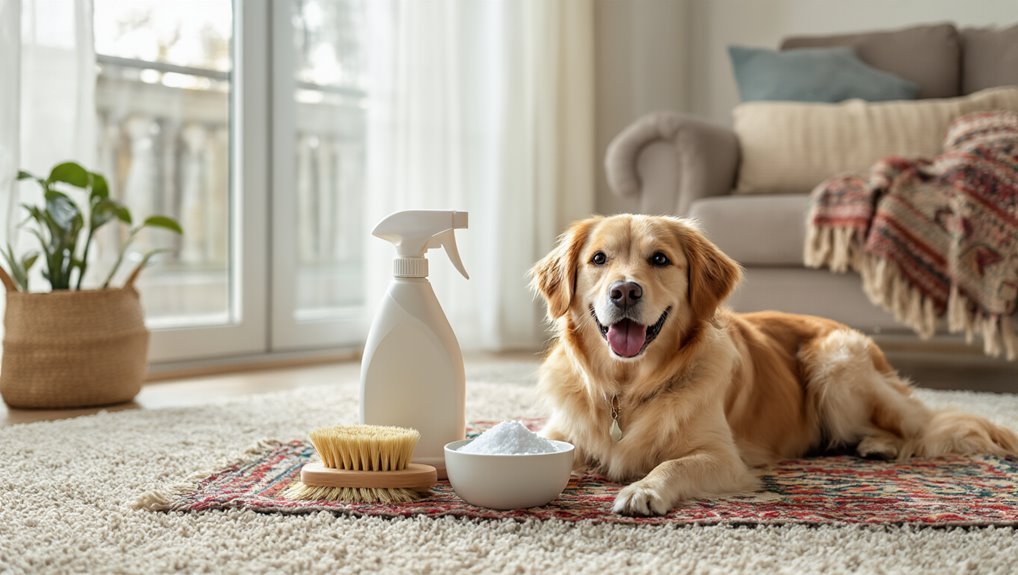
Finding the right carpet cleaning products for your pet-filled home can feel like treading a minefield of harsh chemicals and questionable ingredients. I’ve found that the best solutions actually use biodegradable ingredients that won’t harm your furry friends.
| Product | Key Features | Best For |
|---|---|---|
| Kids N Pets Stain & Odor Remover | Enzymatic, cruelty-free formula | Breaking down organic stains |
| OxiClean Carpet Stain Remover | EPA-safe, 10-minute treatment | Quick pet accident cleanup |
| BISSELL Little Green Pet Eraser | Portable, dual brush heads | Fresh messes like urine/vomit |
Professional services like Magic Carpet Cleaning use plant-based enzymes for a deep clean. For pet owners seeking eco-friendly options, Better Life’s non-toxic formula delivers impressive results. These carpet cleaners prove you don’t need aggressive chemicals to tackle pet odors effectively.
DIY Pet-Friendly Carpet Cleaning Recipes and Techniques
Why spend money on expensive carpet cleaners when you’ve probably got everything you need sitting in your kitchen pantry right now?
I’ve discovered that tackling pet messes doesn’t require harsh chemicals that might harm your furry friends.
Here are my go-to cleaning techniques that are safe to use around pets:
- White vinegar and baking soda combo – Sprinkle baking soda on tough stains, spray with 1:1 vinegar-water solution, let it fizz for 5-10 minutes, then blot and vacuum to attack odors at their source.
- Steam cleaning method – Heat water to 200°F and apply to set-in stains, lifting pet hair and residues without chemicals.
- OxiClean Carpet solution – Mix 1 tablespoon per 16 ounces of warm water for organic matter breakdown.
- Plain baking soda – Sprinkle, wait 15-30 minutes, then vacuum for simple deodorizing.
Choosing the Right Professional Pet-Safe Carpet Cleaning Service
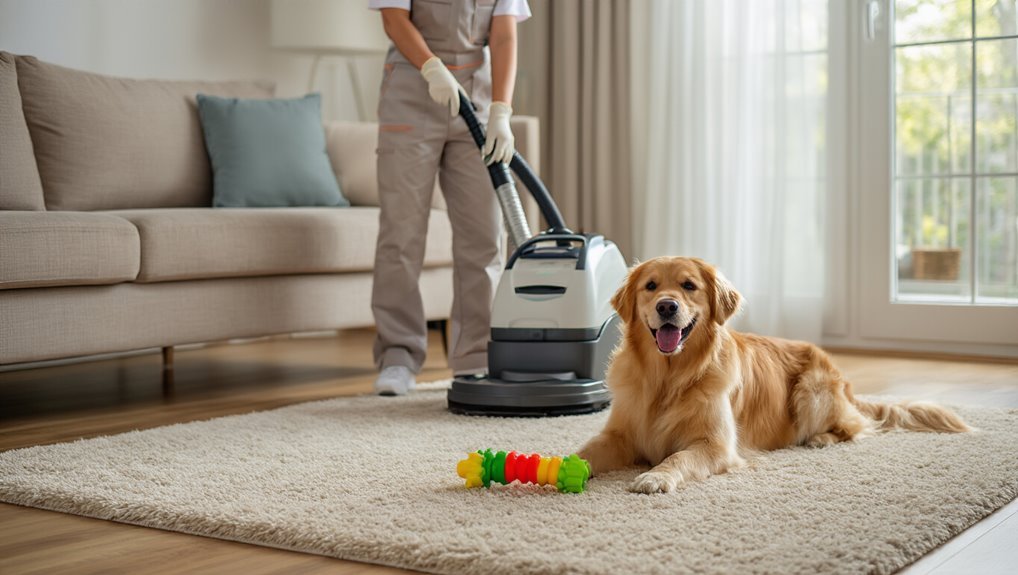
Sometimes DIY solutions just aren’t enough, especially when you’re dealing with those really stubborn pet accidents that seem to have taken up permanent residence in your carpet fibers.
When you’re at your wit’s end, professional carpet cleaning services become your top choice for a home with pets.
I think the key is finding cleaning services that use hot water extraction methods without harsh chemicals.
You’ll want providers who can break down organic stains using plant-based enzymes that are completely free of toxic ingredients.
Well, companies like Magic Carpet Cleaning Boise actually specialize in tackling stubborn odors while keeping your furry friends safe.
Look for services offering free estimates and EPA-approved products.
It’s probably worth the investment when your pet’s health is on the line.
Frequently Asked Questions
What Is the Least Toxic Carpet Cleaner?
While harsh chemicals dominate store shelves, I’d recommend enzymatic cleaners like Kids N Pets for sustainable cleaning. These eco friendly alternatives use natural ingredients, reducing vapor emissions and health impacts compared to traditional options.
What Is the Best Non Toxic Floor Cleaner for Pets?
I’d recommend distilled white vinegar or citric acid-based solutions as the best PetSafe FloorCleaner options. These NaturalIngredients create Effective, ScentFree DIYMixes that offer BudgetFriendly Alternatives to commercial products while ensuring safe EasyApplication Methods.
What Is the Best Pet-Safe Carpet Cleaner?
I’d recommend enzymatic cleaners like Kids N Pets or OxiClean as best brands for stain fighters and odor removers. They offer easy application, budget-friendly choices, and user testimonials confirm their long-lasting effectiveness.
Are Carpet Cleaning Chemicals Safe for Pets?
Most carpet cleaning chemicals aren’t safe for pets due to toxicity levels and health risks. I recommend analyzing ingredients, following veterinary advice, and choosing non-toxic alternatives to prevent long-term effects from chemical exposure.

